If you’re trying to adopt a more eco-friendly way of living, then this post is for you.
Here I decided to list and review the best compostable k-cups, so that it’s easier for you to choose the brand that suits you best.
There is actually another reason why you may be interested in this type of biodegradable Кeurig pod – it’s plastic-free.
By opting for this type of k-cup you’re making sure that no hot water comes in contact with plastic during brewing.
No matter what’s your motivation, I have you covered.
Furthermore, after reviewing the items, I’ll tell you whether k-cups can actually be composted at home.
I’ll also share some other cool ways to make coffee in a more eco-friendly, yet convenient way.
Switching to non-plastic compostable coffee pods is not the only way to go, so continue reading if you want to learn more.
What are the Best Compostable K-cups – Reviews
| Brand: |
|---|
| 1. San Francisco Bay |
| 2. Tayst |
| 3. Beaniac |
| 4. Cameron’s |
| 5. Organic Coffee Co. |
When choosing the best compostable k-cups on the list, I made sure to take a few things under consideration.
Apart from being non-plastic, made of plant-based materials, and biodegradable in one compost cycle, the coffee pods that I chose are also capable of making delicious coffee.
So here are the best compostable k-cups:
1. San Francisco Bay
Click here to see the current price and more photos on Amazon.
The compostable coffee pods by San Francisco Bay are the go-to k-cups for many who are trying to live a more eco-friendly lifestyle.
They are 100% commercially compostable, made of plant-based renewable materials, and are certified by the BPI.
There are several coffee blends that you can choose from.
San Francisco Bay only uses Arabica beans for their Keurig compostable cups.
They are are roasted either dark or medium.
The only one that’s lightly roasted is the Donut Shop blend.
I recommend trying out the Fog Chaser if you like a fuller-bodied, stronger brew.
As you can see, you can also go for decaf biodegradable k-cups by San Francisco Bay.
You should have in mind, though, that there are some disadvantages to using these non-plastic pods. They tend to let some sediment into your brew, so if you want a clean cup of coffee, these compostable k-cups may not be the best choice.
On the other hand, if you like French-press-style coffee, you won’t have an issue with that.
It’s good to know that more coffee particles would find their way to your cup if you go for one of the dark roast blends.
Furthermore, some people who own a Keurig Supreme Plus model, have issues with these pods.
I’d also recommend starting out by getting the smallest (12-count) pack if you own a 2.0 Keurig, just to try them out and see if you’re happy with how they work.
You should keep in mind, that you should throw them out in a commercial composting facility, not in your trash or backyard compost bin.
2. Tayst
Click here to see the current price and more photos on Amazon.
Tayst compostable coffee pods are undoubtedly among the best plastic-free biodegradable k-cups that you can get your hands on.
Apart from being a more eco-friendly alternative to the originals, with these single-serve capsules, you won’t be compromising on your coffee’s taste.
The coffee in them is Rainforest Alliance certified. This certificate indicates that Tayst also makes sure to go a step further and get beans from farmers who use sustainable practices in their coffee production. Furthermore, this Rainforest Alliance certificate program protects the rights and welfare of farm families.
There are several different blends that you can choose from:
- Bold and Brazen;
- Bold and Brilliant;
- Defiantly Decaf;
- Happy Hazelnut;
- Vanilla Cream;
- Medium and Heroic;
- Medium and Magnificent;
If you’re not sure which one to choose, I recommend getting the variety pack.
This way you’ll get to try both bold and medium blends.
I generally prefer the medium ones, as they are more complex yet balanced. If you’re a fan of vanilla and hazelnut-flavored coffee, I recommend getting the flavor sampler.
Tayst Compostable coffee pods should work with the discontinued Keurig 2.0.
Nevertheless, there are individuals who report that some k-cups don’t puncture well in Supreme Plus and 2.0 models. If you have a Supreme Plus or a 2.0 Keurig, I recommend going for a smaller-count pack initially, to see if these biodegradable k-cups work as you’d expect.
With that being said, I’d recommend the Tayst coffee pods to anyone who’s looking for a non-plastic alternative to the original Keurig pods. These compostable pods are not only more eco-friendly, but also capable of producing delicious coffee.
Just keep in mind that they should be composted in an industrial composting facility. You can try to compost them in your backyard bin, but it will likely take too long for them to decompose there. The component which takes the longest is the ring. Since Tayst pods are BPI-certified, you can safely throw them in your local compost and the industrial facility will take care of them.
3. beaniac
Click here to see the current price and more photos on Amazon.
These k-cups by beaniac are not only 100% compostable and BPI-certified, but also made with organic Rainforest Alliance Certified Arabica coffee.
They work with Keurig 2.0, so if you’re an owner of this model, these biodegradable pods are one of the best options that you have.
Furthermore, the coffee they’re capable of producing is delicious.
Nevertheless, it’s essential to point out that you may not be satisfied with how these pods work with newer Supreme models. So if you have a Supreme Plus, go for the smallest pack in your first order.
Anyway, there are a few blends that you can choose from:
I’d recommend starting out with Kickstarter. It’s made with medium roasted ground coffee beans. The blend produces a full-bodied cup with a smooth and balanced flavor.
To be fair, no matter which blend you go for, you’ll likely be happy with your purchase. Especially if you’re looking for a plastic-free coffee pod for your single-serve Keurig maker. Keep in mind it should be composted in a commercial facility, though. So don’t just throw it in the trash or your backyard compost if you’re trying to live a more eco-friendly lifestyle.
4. Cameron’s
Click here to see the current price and more photos on Amazon.
Cameron’s k-cups are undoubtedly one of the best ones that are made to be 100% compostable.
The mesh filter, the ring, and the lid – all of its components are made of plant-based materials.
There are a variety of flavors that you can choose from, such as Chocolate Caramel Brownie, Cinnamon Sugar Cookie, or, if you want a decaffeinated version – a Decaf Breakfast Blend.
You can opt for the blend that suits you best from the convenient drop-down menu on Amazon.
Anyway, many Keurig owners prefer the flavor of Cameron’s coffee better than any other alternative, because of its great taste and variety of flavors.
Furthermore, these pods are non-plastic and biodegradable, which makes them even more appealing to those who are trying to adopt a more sustainable way of living.
The thing is that Cameron’s used k-cups should be composted in a commercial facility, but that’s the case with all the other pods on the list.
Backyard composting isn’t recommended.
These plastic-free pods should work with 2.0 Keurig single-serve coffee makers.
Related Post: What is the Best Keurig Coffee Machine? Comparison & Reviews.
Nevertheless, some k-cups don’t get punctured properly in these newer models, which lets water go down into your cup along with the coffee.
This, unfortunately, happens with other pods on the list too, when used with the Keurig Supreme Plus. That’s why I recommend getting the smallest 12-count pack to see if these compostable k-cups work well with your machine.
Still, Cameron’s compostable k-cups are among my top picks for a reason, so don’t hesitate to try them out.
5. Organic Coffee Co.
Click here to see the current price and more photos on Amazon.
The Keurig pods by Organic Coffee Co. use only organic Arabica coffee beans and are BPI-certified commercially compostable.
It works with the discontinued 2.0 Keurig models. Nevertheless, if you’re an owner of a newer Keurig model that uses the MultiStream Technology®, such as the Keurig Supreme Plus, the pod may NOT get punctured properly.
There are a few blends that you can choose from, including a decaf, and a darker French roast blend, which results in a fuller-bodied cup of coffee.
The Organic Coffee Company is a family-owned American company that’s been on the market for over 40 years.
It’s an established brand with great customer service.
So if you’re looking for a non-plastic k-cup, you won’t go wrong by getting some from the Organic Coffee Co.
How to Store Compostable Coffee Pods?
Compostable k-cups should be stored in an airtight container or in a tightly sealed ziplock bag.
This is so because the mesh filter, which holds the coffee in your non-plastic coffee pod, lets oxygen in. This leads to oxidation, which turns coffee stale.
Regular k-cups are sealed – this limits flavor deterioration, so you don’t need to use a sealed canister to store them.
If you want to learn more about how long coffee pods last, check out this post.
Furthermore, if you’re interested in finding out more about the process of oxidation and how it affects the flavor of ground and whole coffee beans, check out this guide on how long coffee beans last.
With that being said, to store your compostable k-cups, I recommend getting a canister, such as this one by Coffee Gator:
Click here to check out its price and more photos on Amazon.
Are compostable k-cups really compostable?
100% compostable coffee pods should be commercially composted in an industrial facility.
If you throw your compostable k-cups in your home compost pile, it will likely take too long for them to decompose.
When it’s stated that a product is commercially compostable, this means that it needs a specific commercial environment, provided by the industrial facility.
Through the use of a specific composting method, the facility provides the necessary conditions (such as a higher temperature) for the pod to biodegrade within a composting cycle.
Therefore, if you plan on getting a non-plastic Keurig pod and throw it in your backyard compost, this may not be a good idea, as in such an environment it may not really be compostable.
So if you’re interested in getting some of the listed k-cups to minimize your environmental footprint, it may be a good idea to check whether there’s an available composting program in your area.
It’s also worth noting, that throwing your compostable k-cups into your regular trash can, in fact, harm the environment. When sending organic waste to landfills, even if compostable, it releases methane gases as it biodegrades.
This is something that is worth taking into consideration when opting for a non-plastic compostable coffee pod.
It’s also good for you to check whether the product you go for is BPI-certified. This third-party certification by the Biodegradable Products Institute verifies that a certain product will break down during the regular composting process and will not harm the quality of the compost.
A better eco-friendly alternative
If you’re trying to live a more eco-friendly lifestyle, you may be interested in considering some other coffee-making alternatives.
Switching to compostable k-cups may not be the best option in terms of sustainability.
The coffee pod market keeps growing, which means that there’s a further increase in single-use plastic that ends up in landfills.
Even though it’s convenient to use this type of coffee maker, there are actually other more environmentally-friendly, yet easy ways to make coffee at home.
If you’re looking for an effortless, plastic-free way of making coffee, you may want to consider using a French Press.
For example, this stainless steel cafetiere by Coffee Gator will serve you for years.
To prepare a cup you only need 2 to 3 rounded tablespoons of ground coffee and pour 12 fl. oz. (350 ml) of off-the-boil water on top of them.
Then you steep for around 4 minutes and press the plunger to filter the grounds.
No waste other than the spent coffee grounds is generated (and you can actually reuse them).
You can check out my full guide on how to brew coffee in a French press for more details.
You may also be interested in checking my guide on the best French press coffee makers.
French press coffee results in a fuller-bodied brew with a bit of sediment, but so do most of the biodegradable k-cups that I went over.
I have another post, where I review some other plastic-free coffee brewing devices.
There I recommend pour-over drippers that are used with a paper filter that can be composted in your backyard. Furthermore, it doesn’t let any tiny coffee particles into your cup.
Another option would be to get a reusable k-cup, like this one by Maxware.
Click here to check out its price and more photos on Amazon.
All of the aforementioned alternatives will let you use your own coffee of choice, which is a great advantage.
The thing with reusable k-cups is that utilizing them defeats the purpose of a single-serve coffee maker – the convenience.
And, to be fair, you can make better coffee with a French press or a Hario V60, compared to using a refillable Keurig pod.
Related Post: Hario V60 Brew Guide with Photos
At the same time, their ease of use and maintenance are pretty much the same.
Recycling original k-cups is also an option, but, again, requires a bit of effort on your part. You need to separate the components of the Keurig pod and recycle them separately. This recycling tool may make it easier for you to do that.
Final Words
I hope that through my post you found the best compostable k-cups for your taste and needs.
With all being said, if you are here, then you’re probably looking for an eco-friendly, non-plastic product that will let you enjoy delicious coffee at home.
I decided to include some other tips and product recommendations, to give you more insight and make it easier for you to make an informed and sustainable choice.
Leave me a comment below to share your thoughts.

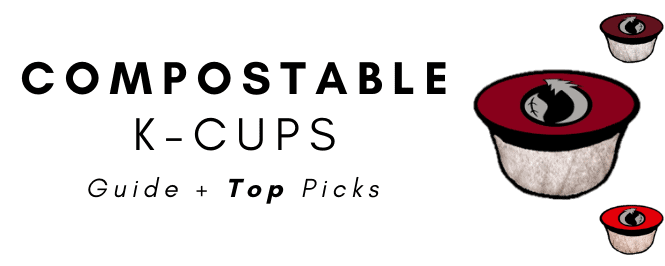
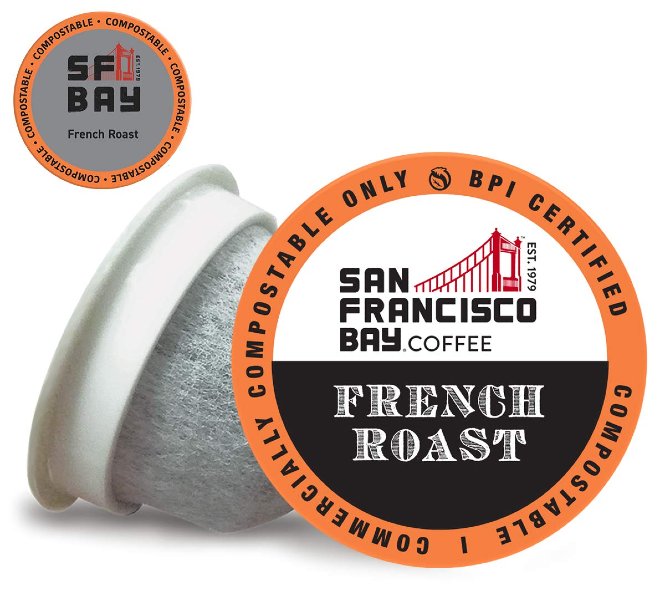
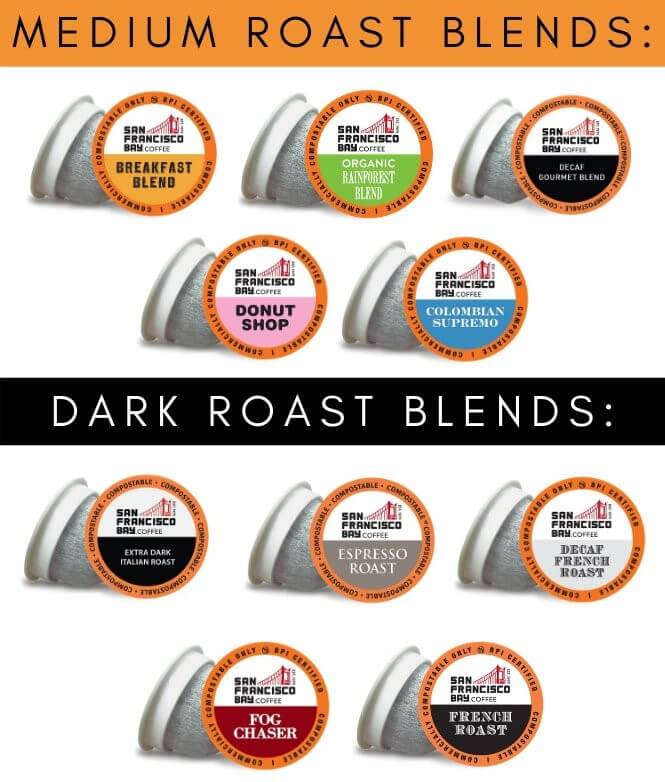



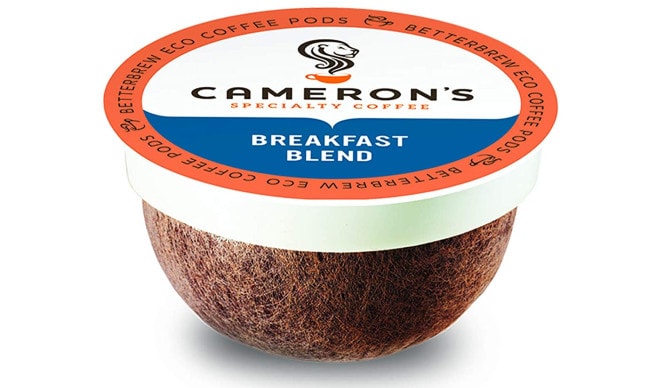



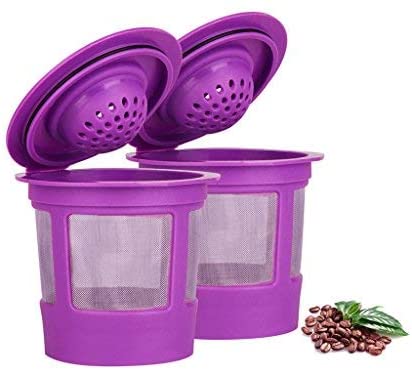
I have used several types of reusable cups in my Keurig 2. There are small ones that I have seen in grocery or dollar stores, sometimes in sets of three. These give you the same brewing options as a standard K-Cup. In order to get them to work in a Keurig 2, you need to salvage the foil cover from a K-cup. You only need a small part of the outer quarter inch of the cover, taped or glued to the edge of the top of the reusable K-cup, positioned at the 9 o’clock position. If you use glue, use something non-toxic.
There is also Keurig’s My K-Cup ($19.99 from Keurig.ca or Canadian Tire). It allows you to brew up to 14 oz. at a time.
Both these options allow me to buy any coarse ground coffee I wish, or whole beans I can grind myself.
Excellent article. Very interesting to read. I really love to read such a nice article. Thanks! keep rocking.